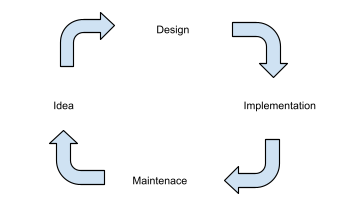Introduction to Enterprise Architecture
Jump to navigation
Jump to search
<slideshow style="nobleprog" headingmark="⌘" incmark="…" scaled="false" font="Trebuchet MS" >
- title
- Introduction to Enterprise Architecture
- author
- Bernard Szlachta (bs@NobleProg.co.uk)
</slideshow>
Processes are not enough ⌘
- Processes has to be somehow executed (infrastructure, hardware, logical organization of data flow, etc..)
- Processes themselves do not focus on the other aspects of the enterprise:
- reuse of services
- reuse of infrastructure
- easiness of implementation and change
- Each stakeholder requires specific information relevant to their position (point of view)
- Changes made by one stakeholder may impact others
- There must be a mechanism to predict the impact of changes to other stakeholders
Enterprise Architecture as a process ⌘
- Process that describe, control an organizations' structure, processes, applications, system and technology
- Methods and techniques for making and using:
- Models
- Visualization
- Analysis of the impact of changes
Architecture, Model, Visualization, Views, PoV ⌘

Architecture Description ⌘
- Architecture Modelling Languages
- Understood by all stakeholders (IT, Business, etc..)
- Allows to analyse and validate model
- Viewpoint
- Aimed at a particular type of stakeholder
- As-is -> To-be
- Qualitative impact analysis
- Quantitative (performance, cost, etc..)
What is architecture ⌘
Building Architecture
- Suppose you talk to an architect to design a house
- You tell them how many rooms and what rooms you like, windows, bathrooms, garden, etc...
- You agree on a master plan, architect produce detailed specifications
- The specification is used by engineers and builders
- You can communicate with the architect because you have a common language (e.g. room, staircase, etc..)
- You know the function of those elements
- You and the architect use, mentally, an architectural model of a house
- The model is abstract, it purposely ignores many details
Enterprise Architecture
- Instead of rooms and windows you will talk about business processes, applications, products, infrastructure
Architecture Definition according to IEEE
Architecture is the fundamental organisation of a system embodied in: * its components * their relationships to each other and to the environment * and the principle guiding its design and evolution.
What is architecture ⌘
Stakeholder according to IEEE
Stakeholder: * an individual, * team, * or organisation (or classes thereof) with interest in, or concerns relative to a system.
Stakeholders and an Architecture
- Only few stakeholders are interested in a system architecture
- Stakeholders are more interested in the impact the architecture has on their concerns
- An architect should be aware of these concerns and discuss them with the stakeholders
Enterprise Architecture (EA) ⌘
Enterprise (The Open Group)
Enterprise: any collection of organisations that has a common set of goals and/or a single bottom line
Enterprise Architecture (The Open Group)
Enterprise architecture: a coherent whole of: * principles, * methods, * and models that are used in the design and realisation of an enterprise's: * organisational structure, * business processes, * information systems * and infrastructure.
Why do we need EA ⌘
- The architecture is more stable than a specific solution
- Provide a holistic view of the enterprise
- Optimization on the Enterprise Level (System Thinking)
- Optimization on a system level may decrease flexibility
- Enterprise is as strong as its weakest link
- E.g. Sales can receive more orders than the production can cope with
- Fast infrastructure can be not flexible enough to cope with the changes required by the business
- EA helps to translate corporate strategy into daily operations (i.e. run processes)
- Combine models from different domains (UML, BPMN, DSL, etc..)
- Defines constraints on systems (and increases coherence)
- Allows choices to be related to the business objectives
- Allows to manage change in the Enterprise
Does an EA changes? ⌘
We adjust EA because:
- Growth of the enterprise (organic, acquisition, etc...)
- Advancements in technology
- Changes in the corporate strategies/goals (market penetration rather than skimming)
- We learnt how to do things better
Current state of EA⌘
- EA discipline is brand new (25 years old, younger than most people in this room)
- Lack of common language (stakeholders got their own language)
- Legacy hangover
- Human languages problem
Architecture as a process ⌘
Architecture is a:
- product (model, graphs, infrastructure)
- process (architecture creation, architecture maintenance, communication, alignment)
- strategy (flexibility vs performance, etc...)

Drivers for EA ⌘
Internal
- Business - IT alignment (top-down, bottom-up)
- Effectiveness (focusing on relationship between components rather than by the improvements between components)
External
- Interoperability with suppliers/buyers (e.g. automatic invoicing)
- Regulations (e.g. SOX, Clinger–Cohen Act, Basel 3)
Can we do not have EA at all⌘
- answer the question as in the title?
Questions ⌘
- Does a good EA hinder innovation?
